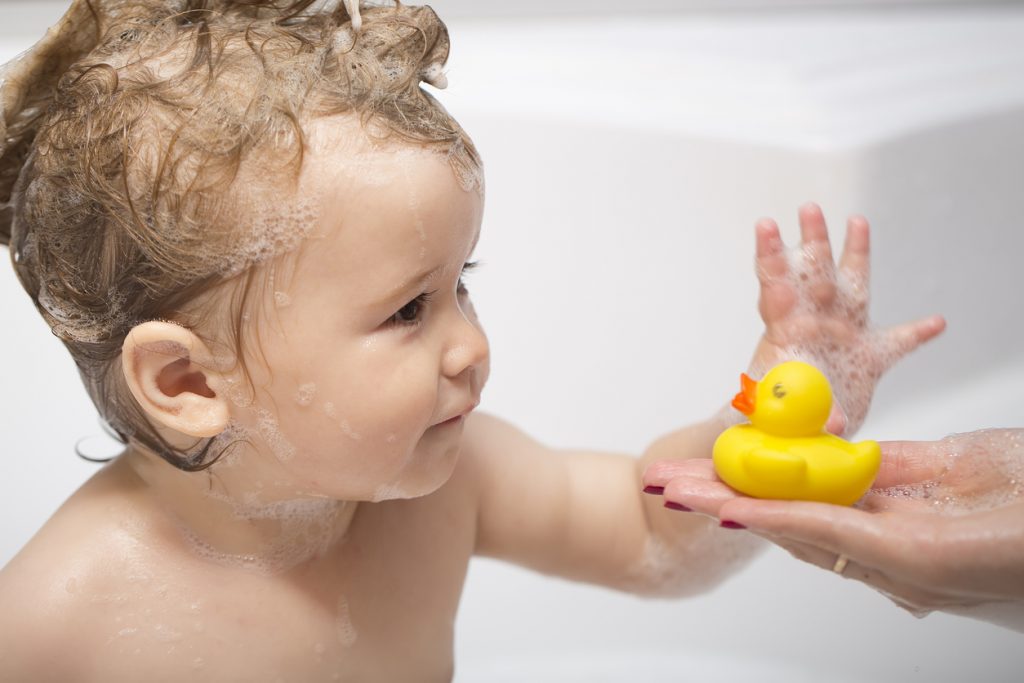Have you ever tried squeezing some of the bath toys your child has used for a few weeks? Toys that have a hole in them can have a slimy blackish-green build-up inside! A 2018 study from Swiss researchers shows that soft plastic bath toys like rubber duckies are breeding grounds for mold, bacteria, and fungi — some of which can make kids sick. The researchers who examined bath toys used by kids found that ALL of them had “biofilm communities” — a “visible and dense” slimy film of microorganisms on their inner surfaces.
The source of these biofilm organisms depended on the combination of four main factors:
- The flexible plastic material that is releasing assimilable organic carbon (AOC) that favors microbial growth
- The tap water microbiome that introduces specific microorganisms to the bath toys
- Nutrients in the bathwater from personal care products and human body fluids
- Microorganisms from the user and environmental contamination
The American Academy of Pediatrics (AAP) recommends avoiding the use of bath toys as much as possible. Per the AAP, bath time is fun and stimulating enough for children without any toys.
What are the health concerns for kids associated with playing with moldy bath toys and/or ingesting water from moldy interiors of bath toys?
Although mold is harmful when ingested, the amount of mold present in bathwater from contamination of the moldy bath toys is usually not enough to make your child sick. However, if you see signs of nausea, vomiting, diarrhea, or an upset stomach, those could be the effects of ingesting mold, just like food poisoning from moldy food.
Mold is a group of fungus. So, you should be especially careful about ingestion of mold-contaminated water, even in small amounts. If your child has a mold allergy or an immunocompromised condition, such conditions can make your child extremely sick, even from small amounts of mold ingestion.
Are there any possible long-term consequences of this?
Healthy children have a good immune function that allows them to effectively handle and fight off mold exposure if they breathe mold spores or even ingest some of it by accident. However, recurrent or increased exposure to mold can make a child sick.
Can you clean bath toys in bleach? If so, how? What dilution ratio would you use?
Yes. You can and should clean bath toys regularly to prevent mold from growing on them or inside them. Ideally, if you see mold in a bath toy, it should be thrown away. If it is a special toy that you want to keep, then it can be cleaned by putting the toy in a mixture of ¾ of a cup of bleach and one gallon of water. You’ll want to soak the toy overnight and then remove it from the solution and let it air dry completely. If you do not see or smell any mold on the toy, it is safe to go back in the bath, but monitor carefully for any mold regrowth.
Is vinegar an appropriate substitute for bleach?
Vinegar is an acceptable substitute for cleaning bath toys. You can make a solution by mixing one gallon of water with ½ cup of white vinegar and soaking the toys in it for about an hour. Then scrub the toys to clean off the mold and then let them air dry. If they still smell like vinegar, just do a simple water rinse and dry completely before your child uses them again. According to Fisher-Price, the toy company, soaking the bath toys in a solution of 50% hot water and 50% distilled white vinegar once a week is ideal for preventing mold formation.
What other ways can you clean bath toys?
Squeezing out bath toys regularly, hanging the bathmats to dry every night, and sealing the holes in new bath toys with a glue gun before you start using them helps prevent mold build-up. Regular cleansing of the bath toys with soap and water followed by drying will prevent mold formation. Fully dry the bath toys after each bath by shaking them off well and setting them on the side of the tub to dry overnight. Store them in a dry place in the morning until they need to be used at bath time.
What sorts of bath toys are the worst for growing mold and mildew? Best?
Flexible soft plastic bath toys and toys with holes in them through which water can get in are the worst for growing mold and mildew. This is because these toys retain small amounts of water inside them even if they are squeezed out “completely,” and water plus a source of carbon, like bath soap and certain compounds in flexible plastic, promotes mold and mildew formation.
Bath toys that do not have holes in them through which water can get into them are the best kind. A rubber ducky type of toy without a squirty hole can be a good option. Also, try to select toys made of solid plastic or toys that can be opened to fully dry. Bath toys made of flexible plastic are the ones that can release assimilable organic carbon (AOC) that favors microbial growth.
Some parents worry about any use of bath-time toys due to the risk of mold exposure. It is not a practical approach to try and create a sterile environment for our kids. But following basic hygiene and trying to dispose of toys that cannot be safely cleaned will make your child’s bath time safe and fun!






Comments